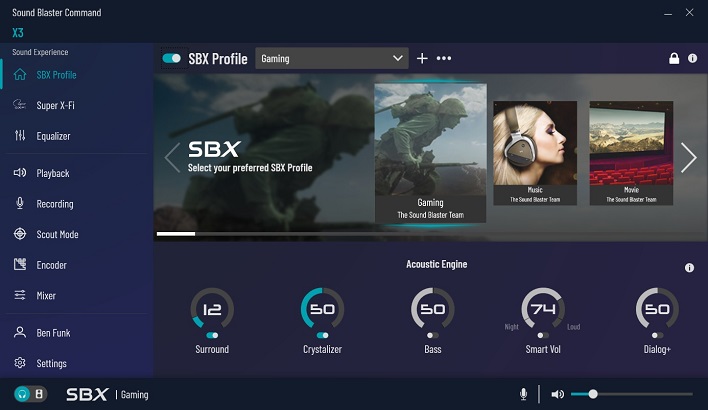Sound Blaster X3 Review: Portable Super X-Fi Audio For PCs And Consoles
Sound Blaster X3: Software Experience
Much like the Sound BlasterX AE-9 before it—and any other Sound Blaster product currently available—Creative's Sound Blaster Command is in charge of configuring the audio card's bells and whistles. If you've used Sound Blaster Command, much of this might already be familiar, but we'll cover the most important parts for those who are unfamiliar. The various areas of the application fill the menu on the left, and the biggest part of the window is dedicated to tweaking those settings.
The application's primary page is the SBX Profile page. Here you can pick between the most common use cases: Gaming, Music, or Movie, and select one of several pre-configured profiles for each. For example, the Gaming profiles include several high-profile games like Counter-Strike and Call of Duty, where Music and Movie contain different genres. If you don't find Creative's settings to your liking, you can adjust each preset here and save them as your own. There are separate controls for Virtual Surround simulation, the Crystalizer high-frequency exciter, Bass Boost, the Smart Volume automatic dynamic range compressor, and Dialog Enhancer which brings out frequencies typically occupied by the human voice. It doesn't take too much tweaking of any of these knobs to over-do it, and more often than not Creative's profiles apply them subtly.
Super X-Fi is Creative Labs' new AI-assisted room simulation technology. The Super X-Fi mobile app captures images of your face and ears, and creates a map that indicates how your ears naturally capture audio in a room. Super X-Fi attempts to make whatever we're listening to sound like it's in the room with us instead of directly pumped into our ears with headphones. We'll dive into how it works and how to set it up in a bit, but the nice thing we can see here is that multiple head maps are supported. This will let you switch between profiles, so that if a machine is shared between a couple of users (for example, our Nintendo Switch is shared among several people in our household) switching between those profiles is easy. Unfortunately, you can't rename the profiles, so you'll have to figure it out based on the date-stamp on the profile to figure out who's who.
The Equalizer tab lets you save four preset EQ settings for Super X-Fi mode, and then gaming, music, and movie modes. You can switch between these with a press of the Mode button on the front of the Sound Blaster X3. Using these settings is as easy as dragging points around on the graph. It's up to you to know what each range represents, though. Creative has helpfully included several profiles for each setting so that if you'd rather, you can just pick the setting that sounds best to you for whatever you're listening to. Otherwise, you can just turn the Equalizer settings off for a flat frequency response using the toggle in the upper left.
Playback options let us switch between Speaker and Headphone mode, but this is also accomplished by holding the SXFI button on the front of the Sound blaster X3. When the amber and green LED is dim, the Sound Blaster X3 is outputting through the speakers. You'll need to use this page to set up your speaker arrangement, though. It defaults to stereo desktop speakers. You can also switch headphone gain settings and even remember the last-used gain setting. You can also turn Direct Mode on here, which bypasses all of the Sound Blaster X3's DSP hardware and outputs exactly what's coming in. This is handy when you're looking for pure unadulterated audio, or need to play back the highest-quality settings, since the DSP is only capable of reproducing 24-bit, 192-kHz audio. That's pretty high-fidelity sound on its own, but remember that the Sound Blaster X3 can play back 32-bit, 384-kHz sources.
When you want to record audio through the Sound Blaster X3, you can do so through the microphone input on the front, or the stereo line input on the rear. This control panel lets you select the recording level for each, but both inputs are active. That means you can record from the line input and the microphone port at the same time, but they're blended on the same input channels. The Voice Clarity switch enables noise reduction, echo cancellation, and other vocal enhancers. The Voice Morph is fun to play with, and does a good job of disguising voices.
The mixer lets you adjust the audio between different inputs and outputs. There are separate settings for speaker and SP/DIF optical output, but not separate speaker and headphone settings. Instead, the Sound Blaster X3 remembers how high the volume slider was set for each output mode, and automatically restores the last level when you switch to that output mode. Monitoring levels for the Microphone and Line-In jacks are separate, however, and so is the recording level for each. What U Hear, which records everything routed through the sound card, is available as a capture source, too.
Next up, we'll dive into what Super X-Fi does and how it works.












